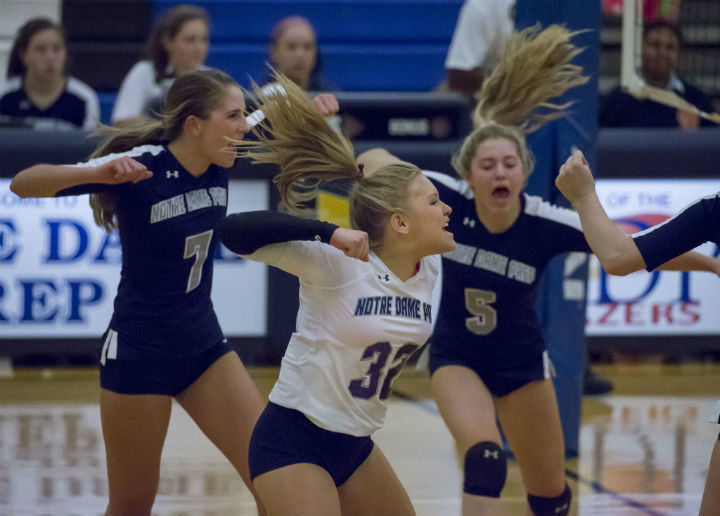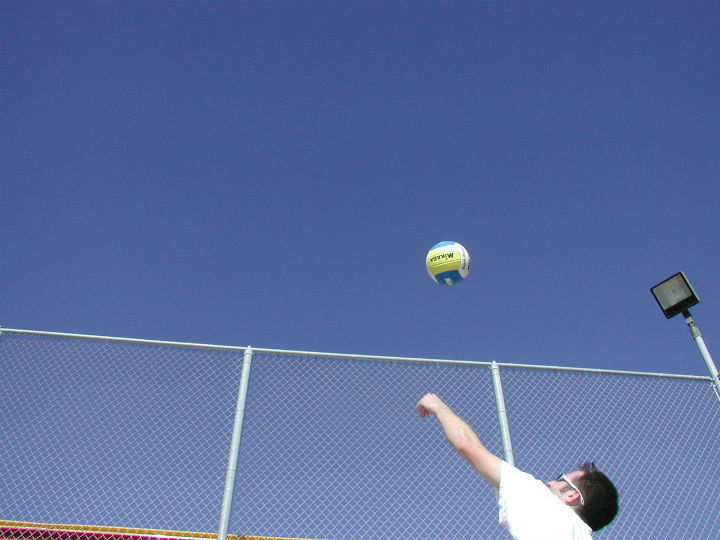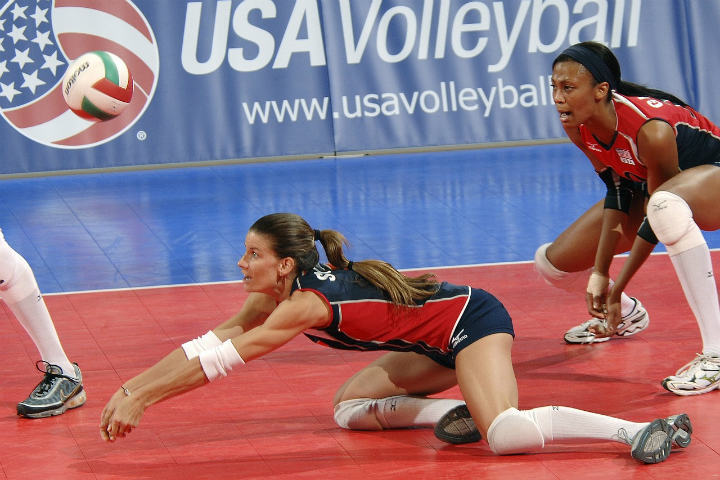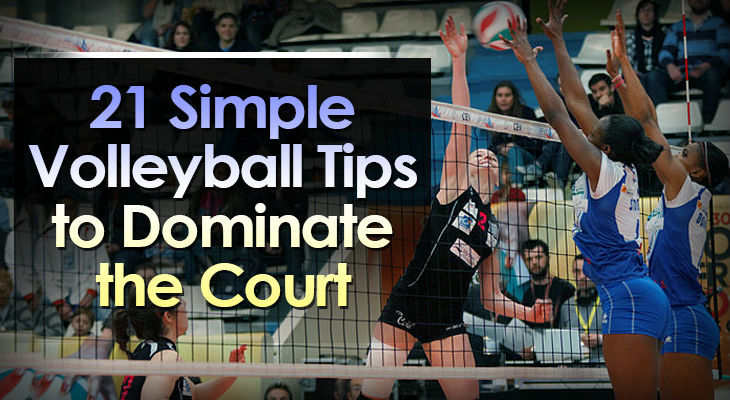21 Simple Volleyball Tips to Dominate the Court
Elite volleyball players breathe, eat, and sleep volleyball.
They’re committed to daily training and they’re constantly looking up volleyball tips and tricks to improve their current skills.
But not every player thinks like this…
There are many players out there who want to achieve success, but they’re either not committed to the process or they don’t know how to improve.
This article aims to fix that!
Below, we’ll show 21 simple volleyball tips that will help you improve your weaknesses and hone your strengths.
Any level player can work through these tips to ensure steady improvement and refining of their skills.
Let’s get started…

1. Get a Calendar
Big improvements can only be accomplished with regular, scheduled practice.
If you’re not spending time improving your skills, there’s very little chance you’re going to get better.
And busy schedules do not lend themselves to ‘sneaking in’ time to practice…
It’s incredibly important that if improving your volleyball skills is the goal, you’re setting aside time each day to practice and improve.
There’s a good reason this is the first tip…
It’s nearly impossible to do something consistently without scheduling it ahead of time.
Think of practices and workouts as your ‘appointments’ with volleyball.
If you set aside the time and stick to the calendar, improvement will happen for sure!
2. Wear the Right Shoes
This might seem like a silly tip that couldn’t possibly make that big of a difference…
But it’s important!
Proper footwear can make a huge difference in how you feel on the court.
Great shoes will ensure that you feel quick and nimble on your feet, providing quickness both laterally and vertically.
They also play an important role in player safety.
Properly fitted shoes that are appropriate for volleyball will ensure stability, reducing the risk of ankle injuries when jumping or landing.
3. Practice the Toss
For an accurate overhand or jump serve, a consistent toss is important.
The swing plays a major role in the ultimate force of the serve, but a good toss is vital for predictability so full focus can be placed on timing the swing for maximum impact.
Even a simple overhand serve that lacks power must still have a well-placed toss to be aimed accurately.
And the only way to develop a consistent, predictable toss is with practice.
Start each workout session with 10 – 15 tosses that are exactly where you want them.

4. Hit All Six Thrice
A good serve hit to the wrong place is no longer a good serve.
It is vital for a volleyball player to not only be able to consistently serve over the net, but to be able to place that serve exactly where they or their coach want it.
If a coach notices a weak passer on the opposite side, they will often suggest a serve be directed to that poor passer.
Practice hitting specific spots on the floor by imagining six spots on the opposite side of the net:
Three along the ten foot.
Three just in front of the back line.
Hit each of those spots three times for a great drill to develop accuracy on your serves.
5. Develop a Routine
Like all sports, volleyball requires a certain amount of muscle memory to be successful.
The more you practice a routine, the easier it is to do it the same way each time.
The pre-serve routine is one of these routines that should be rehearsed and repeated ahead of time so it comes to you second nature during a game.
If there is too much thinking during the pre-serve moments, it will lead to service error
Practice serving all the way back to the routine when receiving the ball for service.
This way, when it comes time to serve in a game, everything is done the same way as it was in practice…
No thought required!
6. Bend the Elbow for Recovery
Every volleyball player has developed the ‘yips’ at the service line throughout their career.
Whether it’s overthinking the location of the serve or just being unable to get it across the net for one reason or another, it can be infuriating.
When this occurs, it’s time to get back to basics…
Use a normal, consistent toss.
Bend the elbow to almost 90 degrees on the hitting arm.
Take a nice easy swing.
This will not be the world’s fastest serve or the most difficult to return, but it will provide a consistent ball that gets over the net.
Once you see one go over, the yips may be gone for good.
7. Be Unpredictable
The opponent is always working hard to get an understanding of your tendencies…
They’re watching how you prefer to hit, where your serves land, and how you line up on serve receive.
So it’s vital to be a little unpredictable throughout the match.
“How?”
Hit balls with different pace.
Serve to all six spots.
Switch your angles on serve receive from time to time.
This will not allow the opponent to develop a solid strategy to take advantage of you.
If you are uncomfortable being diverse in a certain skill (for example, if you have a hard time serving to your left), then work extra hard on that aspect of your game during training.
8. Force Their Hand
It is important to understand that you can dictate what your opponent does by predicting their tendencies and taking them away.
If an opponent tends to prefer to serve short, then get in position to receive a short serve.
If they tend to hit across court, set the block to take that away or use that knowledge to get to the dig more quickly.
Just as it is important to be diverse, it is vital to be aware of your opponent’s lack of diversity.
Once you understand what makes them comfortable, take that opportunity away and watch them struggle!
9. Move Way Back
There is nothing that kills an offense more than having to consistently move back to receive serve…
And then attempt to move back forward to attack.
If you have front row responsibilities but are helping in serve receive, get as far back as you are comfortable with.
This allows you to make a good pass and be moving forward into your attacking role at the same time.
It is virtually impossible to move back to pass, then forward to attack with any real impact.
10. Serve Where They’re Not
It’s natural to find it easier to hit an obvious target, like an opposing player, with a serve.
It’s a little more difficult to train the eye to find an opening to serve to.
The goal of any serve is twofold:
a. Get it over the net
b. Get it in the court
An accomplished player develops a third goal over time…
Ace it!
There is zero possibility of an ace if serves are consistently aimed at opponents.
Finding the holes and being able to hit them are vital to a high percentage chance at an ace.
Practice serving to very, very small targets on the court.
Do not settle for just “getting it over and in.”
11. Find Their Passing Achilles
Most players prefer to pass from one side of their body over the other.
Whether it is just a more natural feeling or how they have developed over time, it just feels easier to pass from a certain direction.
Gaining insight on an opponent’s preference will allow you to serve to the opposite side of their preferred side.
Serving to the ‘weak’ side of a passer throws them off their normal routine, resulting in a bad or overpass, and eliminating the offensive threat of the opponent.
12. Get Low and Stay Low
Nothing takes more time than getting into and out of good defensive passing position.
Players responsible for back row defense, and coverage, should always be prepared to pass.
This means staying low throughout the rally, rather than standing up to run.
Practice staying low for extended periods of time by doing long wall sits and shuffling sideline to sideline.
This will allow you to feel comfortable in defensive position for extended periods.

13. Stay Upright
Everyone loves a diving dig with an impressive roll to cap it off, right?
This is the ‘big play’ in the volleyball world that gets the fans on their feet.
However, any player that is not upright with their feet solidly square on the floor is an ineffective one.
In some cases, you may have no choice but to dive…
But you are much more effective as a passer with a solid base.
Try to stay upright as much as possible and avoid spending excessive time diving and rolling for balls.
14. Get to the Line
There is nothing more infuriating than watching a player, who had every opportunity in the world to make a play, watch a ball land in bounds from just feet away.
In most cases, this is because the player decided the ball was out before knowing for sure.
There is only one guaranteed way to ensure this never happens…
Get to the line!
If a ball is popped up and heading down towards the court, even if it appears obviously out, the responsible player should get to and straddle the line just in case.
That way, if it is going to be a close call or in, you are prepared to make a play rather than looking like the lazy one.
15. Every Ball Could Be Yours
There has never been a case where one player receives all the hits, passes, and sets in a game.
It is important that you have the mindset that every ball could or will be yours.
At no point should a player on the court not be involved in the game.
The best way to avoid wandering in a daze is to assume that any ball in motion may be coming at you next.
This ensures you are always in proper position and ready to make a play.
16. Communication is Everything
Even the highest-level players can sometimes go radio silent for one reason or another.
Sometimes they are frustrated with their play, or the referee, or simply how the match is going.
It is vital that you are always communicating with your teammates.
Whether that means calling for a ball, letting a setter know you are available, or calling out opponent tendencies.
Communication is key for a volleyball team to be successful and if you are communicating to your teammates, they are likely responding as well.
17. Be Prepared to Set
Obviously, the setter has a unique skill set that requires its own tips and practice habits.
However, each player on the floor should be prepared to have to set in a dire situation here and there.
Sometimes the setter will be taken out of a play physically and the player with the best play on the ball may be you.
It is important to practice setting skills to ensure they are serviceable if called upon in a game.
Do not neglect this skill in the name of never needing to use it.
There is nothing uglier than a perfect pass with a botched set.
Do not be the botcher!
18. Face the Target
Directing a pass, or steering it, is a difficult skill that can be learned over time.
But even the best passers will tell you…
If you can get square and face your target, then do so.
Do not be lazy with a seemingly easy pass by trying to direct it if you are able to get square to your target.
Facing your target provides a consistent pass that is easier to set than one that is being directed.
Make your setter happy and pass facing them.
The reward will be a beautiful set and a great offensive opportunity.
19. Lift and Stretch
The best volleyball players are like human springs combined with Stretch Armstrong…
They can jump as high as they want and contort their arms into any position.
These attributes are often achieved by both strength training to create strong, explosive muscles, and stretching.
Volleyball strength is developed off the court by weight training, speed training, and plyometric training.
While on the court skills are essential and must be practiced, they are far more effective with the appropriate off-court development mixed in.

20. Know Your Role
It is vital to be aware of the responsibilities of your position.
A volleyball player that must be informed of rotational assignments, coverages, and defensive placement is an ineffective player.
Volleyball is a fast-paced game that requires the entire team be a knowledgeable unit.
Spend time studying your rotation and assignments so they are natural during the game.
This will ensure you can focus on the physical aspects of the game and not be worried about where you are supposed to be.
It will also free up your teammates to do their jobs and not be worried about you.
21. Be Positive
Volleyball is an emotional game that can drive even the most patient player crazy.
There are many things that can happen during a match that could start a spiral of negativity.
It’s the teams able to maintain their cool who will be in the best position to win.
Frustration can lead to distractions amongst the team, which leads to poor play.
A positive attitude rubs off on teammates and allows them to play with clear minds, free of the negative thoughts.
The best volleyball players are leaders amongst teammates, pushing them positively toward the end goal of winning.
Conclusion
The key to using these volleyball tips to develop and improve your volleyball skills is to actually get out there and put them to practice.
During games, at workouts, and throughout team practices.
The first tip was designed to inspire you to make a plan and stick with it.
Practice may not make perfect…
But it will certainly make you a better volleyball player.

